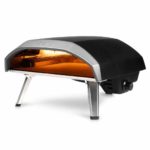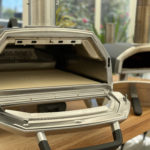How Does An Indoor Pizza Oven Work?
Pizza wouldn’t be the same without its iconic, crispy and bubbly crust. But getting that perfect base requires high temperatures achieved only through specialised pizza ovens – indoor pizza ovens! An indoor pizza oven is a specialized piece of kitchen equipment used to bake pizzas perfectly every single time.
It uses radiating heat from the walls and floor of the dome to cook the meal in minutes. From regular electric-powered models to wood-fired favourites, finding out about their features, preheating techniques and maintenance can help make a fully informed purchasing decision for your homestyle baking needs.
How Indoor Pizza Ovens Work?
Temperature Control And Heating Elements
Temperature control is an essential part of successful indoor pizza oven cooking. Different types of pizza ovens achieve temperature control, depending on the model being used – gas or electric-fired models may use different sources of energy to heat up and keep a consistent temperature during operation.
The heating elements installed in modern pizza ovens have come a long way since the early versions – these are usually made from bright nickel-chrome which can conduct heat rapidly for faster cooking and ensure uniform heat distribution across the entire cooking area.
This makes it possible to cook pizzas with even topping coverage without overcooking any areas thanks to accurate temperature control and no hot spots or cold corners where soggy crust would be formed as a result.
Cooking Surface Materials And Insulation
When it comes to enjoying the perfect pizza, it’s vital that the oven is up to scratch. An indoor pizza oven is designed with components specifically tailored to produce delicious pizzas and other tasty dishes like bread and calzones.
One notable aspect of both home-built as well as pre-manufactured indoor pizza ovens is their ability to maintain consistent temperatures within a relatively narrow range – something achievable only through meticulous design which puts particular attention on two elements: insulation materials used, and type of cooking surface employed.
Temperature control requires high levels of thermal mass absorption which can be provided by ceramic fibre insulation for example – this ensures not too much or too little energy escapes from the interior chambers.
In addition, a good amount of heat must also be stored inside the material forming flooring component – concrete works particularly well here since it has an excellent capacity in maintaining large amounts of warm air while expelling moisture quickly as needed.
Preheating And Cooking Techniques

Preheating and cooking techniques play an important role in how well your indoor pizza oven performs. Preheating is key for attaining the desired temperature for a successful cook and should be done prior to placing the toppings on the pizza.
If you don’t preheat your indoor oven, it could result in unevenly cooked or burnt pizzas. After setting the desired temperature, there are several different cooking methods that you can use depending on what type of recipe you’re trying to achieve.
Stone or brick cooking is one technique used commonly with pizzerias due to its ability to evenly heat a thin crust while keeping its softness underneath as it crisps up above.
Another option would be pan cooking which uses low temperatures throughout with no direct flame allowing pies such as deep-dish styles ample time to cook all the way through without burning while still providing great flavour from charring along edges.
Maintenance And Safety Tips For Indoor Pizza Ovens
Cleaning And Upkeep
Regular cleaning and maintenance of an indoor pizza oven are extremely important for creating delicious, evenly cooked pizzas safely. It helps to prolong the life of the oven and maintain optimal performance while minimizing the risk of hazards.
The frequency and intensity of upkeep depend on multiple factors, such as the type and material of your appliance, but regular care is vital across all models.
For wood-fired pizza ovens, high temperatures during cooking kill germs or bacteria so deep cleaning with detergents is not required – though a periodic wipe-down should still be done with damp cloths occasionally.
However outdoor pizza ovens may require more frequent hot water cleaning due to their exposure to elements such as moisture or debris from outside sources, ensuring that it has cooled down before doing so (with the gas supply turned off).
In addition, there are specialized companies that offer chimney sweeping services which should also be used periodically in order to comply with safety regulations and ensure a smooth working system free from blockages caused by accumulated ash built up within its interior components.
Proper Ventilation
Proper ventilation is one of the most important safety considerations when it comes to indoor pizza ovens. If not correctly ventilated, indoor pizza ovens can produce dangerous exhaust gases such as carbon monoxide and other hazardous pollutants which may put users and their family members at risk.
To ensure kitchen ventilation, a strong range hood must be installed close to the pizza oven so that all harmful fumes are properly extracted from the area. Carbon Monoxide detectors should also be installed in areas where an indoor pizza oven is in use to detect levels of this deadly gas before it reaches unsafe levels.
Aside from safety concerns, proper ventilation is also important for optimal cooking results when using an indoor pizza oven due to temperature control and circulation issues.
Traditional side wall designs or centre vent placement will help maintain consistent temperatures inside the enclosed space without drastically altering flavour profiles or causing food items to taste too smoky/burnt or undercooked depending on the preference/style of cooking desired by the chef.
Safety Precautions During Use
When using an indoor pizza oven, there are a few important safety considerations that should be taken into account. For starters, it is important to ensure proper ventilation and keep the space around the oven free from combustible materials.
Additionally, make sure the oven is securely placed so it doesn’t tip over or shake during use. When operating your pizza oven you must also be aware of heating elements and control temperature to avoid combustion or smoke inhalation.
Make sure to check your user manual for suggested temperatures, as this can vary based on the type of fuel used (wood, gas etc.).
It’s also important to regularly clean out ashes and creosote build-up when burning wood in particular – if left unchecked this can cause dangerous fires or chimney blockages.
Ideally, have a professional inspect and clean your chimney at least once every 1-3 years depending on how frequently you use it as they will know what techniques are best employed in each individual case.
Conclusion
In conclusion, an indoor pizza oven is a great way to experience the classic wood-fired flavours of pizzas you love in the comfort and convenience of your own home. The process for using an indoor pizza oven may vary depending on its type, but all follow a similar basic principle – high heat and insulation work together to create the perfect pizza.
As with anything that works with fire, it is important to keep safety and maintenance top of mind when using an indoor pizza oven. Cleaning between uses and proper ventilation are key elements to ensure everything keeps running smoothly while protecting users from any potential accidents or harm.






